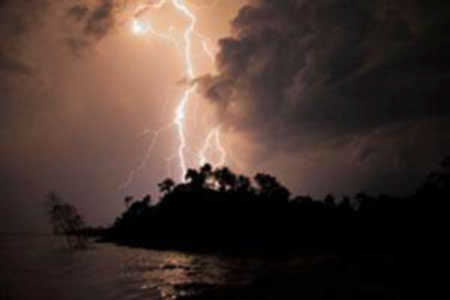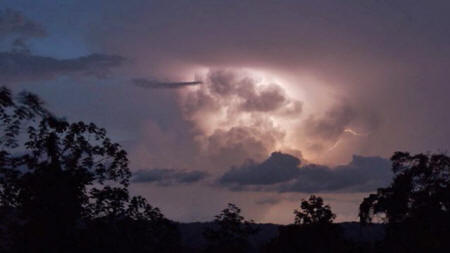|
|
|
from
AmazonRainforestNews Website
But what if they are also its heart? This is exactly what a couple of meteorologists claim in a controversial new theory that questions our fundamental understanding of what drives the weather.
They believe vast forests generate winds
that help pump water around the planet.
But now Victor Gorshkov and
Anastassia Makarieva of the St Petersburg Nuclear Physics
Institute in Russia say that forests also create winds that pump
moisture across continents.
Water vapor from coastal forests and oceans quickly condenses to form droplets and clouds. The Russians point out that the gas takes up less space as it turns to liquid, lowering local air pressure. Because evaporation is stronger over the forest than over the ocean, the pressure is lower over coastal forests, which suck in moist air from the ocean. This generates wind that drives moisture further inland.
The process repeats itself as the
moisture is recycled in stages, moving towards the continent's heart
(see diagram). As a result, giant winds transport moisture thousands
of kilometers into the interior of a continent.
But, they say,
The scientists, whose theory is based on the basic physics that governs air movement have dubbed this the "biotic pump" and claim it could be "the major driver of atmospheric circulation on Earth".
This is a dramatic claim. The two
Russians argue that their biotic pump underlies many pressure-driven
features of the tropical climate system, such as trade winds, and
helps create intense local features like hurricanes.
Likewise, in northern Australia, rainfall drops from 1600 millimeters a year on the coast to 200 mm some 1500 kilometers inland. In contrast, on continents with large forests from the coast to interior, rainfall is as strong inland as on the coast, suggesting the trees help shuttle moisture inland (How Forests Attract Rain - An Examination of a New Hypothesis).
In the Congo, for instance, around 2000 mm of rain falls each year at the coast and the same amount falls inland.
The same is true in the Amazon, the Siberian Arctic and the Mackenzie river basin in northern Canada. But the US, largely forested until recently, now seems be headed for desert.
Makarieva and Gorshkov told New Scientist that without rapid reforestation,
The Russians' ideas have languished since they were published in a small journal in 2007.
Antoon Meesters of the Free University in Amsterdam, the Netherlands, recently described it as,
Meesters does not dispute the physics behind the Russians' theory but claims the effect is negligible. This week, a leading British forest scientist based at the Institute of Tropical Forest Conservation in Kabale, Uganda, came to the Russians' aid.
In a review of the work in the journal Bioscience, Doug Sheil and his co-author Daniel Murdiyarso underline the importance of the idea.
Sheil explains that current theory doesn't explain clearly how the lowlands in continental interiors maintain wet climates.
The biotic pump "may be the answer".
He calls the Russians' findings,
Many forest scientists are intrigued by the idea.
He says it could offer a more convincing
explanation for how Amazon rainfall is typically recycled six times.
If their theory is correct, it means that large forests help kick-start the global water cycle.
However, because forest models do not
include the biotic pump, it is impossible to say what wiping the
Amazon off the map would mean for rainfall worldwide.
Last month, the UK's Met Office warned that if the planet warms by 4 degrees, 85 per cent of the forest could dry out and die. If Gorshkov and Makarieva are right, the Amazon will be gone before warming kicks in. They predict that even modest deforestation could shut down the pump and reduce rainfall in central Amazonia by 95 per cent.
The same could happen in the world's
other large rainforest regions, such as central Africa.
It's not all bad news. If natural forests can create rain, then planting forests can, too.
Sheil says, if forests attract rain, then replanting deforested coastal regions could re-establish a biotic pump and bring back the rains.
|



